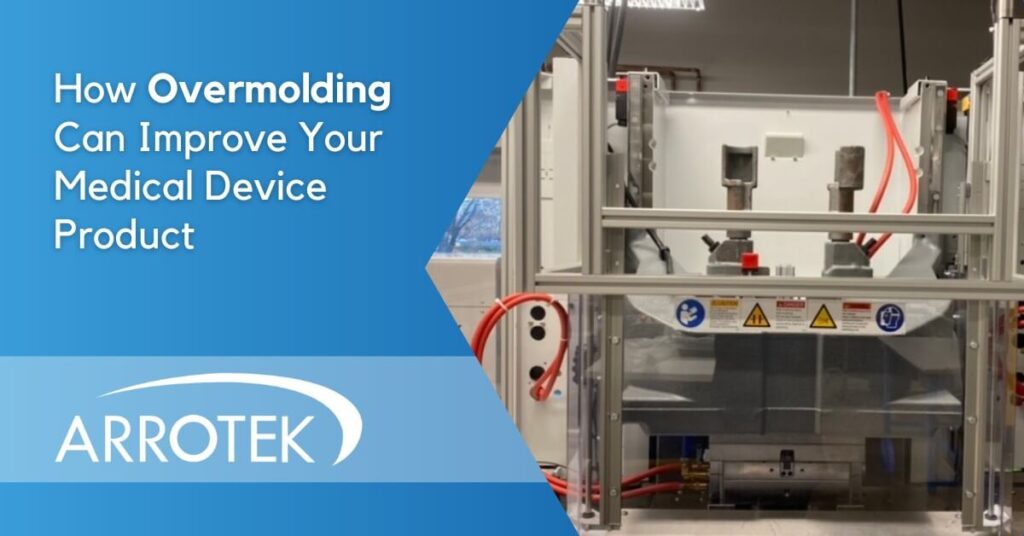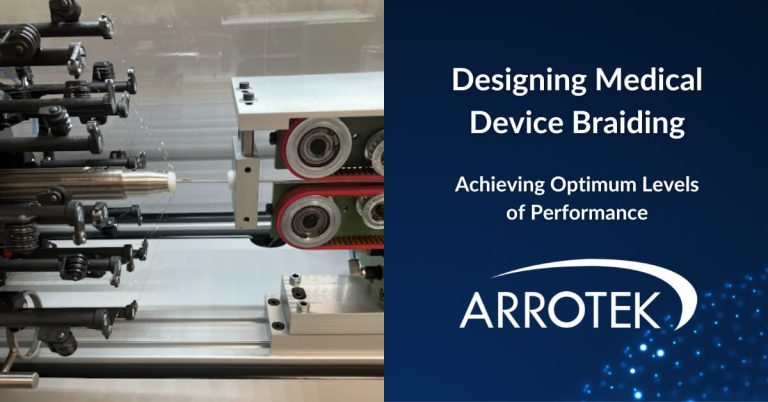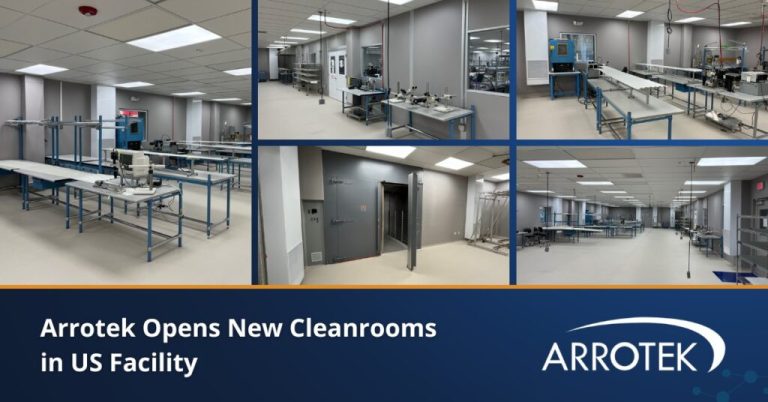By Conor Thompson
The manufacturing techniques used in the production of your medical device product will have a significant impact on everything from quality to manufacturability to costs. Overmolding is one manufacturing technique that can have a significant and positive influence on all these factors.
In this blog, we’ll explain how overmolding works, how it impacts manufacturing, the role that robotics play, and the benefits to your business.
What is Overmolding?
Overmolding is a type of injection molding manufacturing process where one component is fully or partially molded over another. So, instead of the two components being manufactured separately and assembled by another process, they are manufactured together as a single part.
At Arrotek, for example, we regularly overmold polymers onto metals using the insert molding process described below.
There are two main types of overmolding – two-shot molding and insert molding.
Two-Shot Molding
In a two-shot molding process the primary component geometry is molded during the first shot produced by the machine, the secondary geometry is then molded with a different material during the second shot.

Insert Molding
In an insert molding process, the inner component is manufactured using a different technique, such as CNC machining. This component is then inserted and overmolded with a different material.

How Overmolding Impacts the Manufacturing Process
- Superior adhesion between components
- Makes it possible to use smaller components in the manufacturing process
- Fewer individual components are required to manufacture the product
- Streamlined manufacturing and assembly due to reduction of required steps
- Increased throughput on the production line
- Suitable for high-volume, high-speed production lines
- Easier to achieve the desired aesthetic qualities for the device
- Reduced waste
The Benefits of Overmolding
- Improved product quality
- Improved patient treatments and outcomes
- Reduced manufacturing and assembly costs over the medium and long-term
- Improved product performance
Product Performance Features that Overmolding Can Enhance
The benefits outlined above are largely due to the performance features that overmolding can enhance and facilitate.
Those product performance features include:
- Improved resistance to abrasion
- Enhanced waterproofing and sealing capabilities
- Improved grip and tactile qualities, leading to improved ergonomics
- Optimized chemical resistance
- Electrical insulation capabilities
- Addition of colors
- Enhanced vibration resistance
- Improved strength and durability
Where Do Robotics Fit In?
Advanced robotic technologies can be designed to automate the overmolding process. In a two-shot overmolding process, this includes:
- Reorienting the primary component created in the first shot to accurately position the component for a second shot
- Transferring the component created in the first shot to a second mold for more complex designs
In an insert overmolding process, this includes:
- Conveying insert components to the molding machine for loading
- Accurately loading one or more inserted components into a mold
For both two-shot and insert molding technologies, automation can also be used in the form of an End Of Arm Tool (EOAT). Advanced EOAT is capable of gripping, removing, and inspecting final overmolded components of all sizes. Furthermore, an EOAT can be utilized for items such as degating, unthreading, and transferring components to downstream processes.
The above capabilities lead to additional manufacturing process benefits for your medical device product:
- Reduced human interaction with the product during the manufacturing process
- Reduced contamination concerns
- Increased process consistency and efficiency
- Increased component consistency and quality
- Increased opportunity for team member cross-training due to fewer operators being required on the production line
The Challenges of Overmolding
While there are substantial manufacturing, product quality, patient, and business benefits that come with overmolding in the medical device industry, there are also challenges. These challenges include:
- The initial development of the manufacturing process for the product is more complex with overmolding
- Developing overmolding manufacturing processes require a high level of precision during the design of the product and the selection of materials
- Specialized expertise and experience are required to design and manufacture the mold and other equipment required for overmolding
How to Overcome the Challenges
While there are challenges, they should not be regarded as prohibitive, particularly when you partner with an experienced medical device manufacturer. At Arrotek, we have extensive expertise in both aforementioned overmolding processes. We also have a significant level of experience using robotics in the design and manufacturing of custom specialty needles, cannulas, stylets, and similar steel components.
To discuss your requirements and to find out more, please get in touch.





